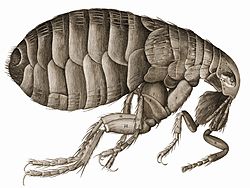蚤
Appearance
| ||||||||
Translingual
[edit]Han character
[edit]蚤 (Kangxi radical 142, 虫+4, 10 strokes, cangjie input 水戈中一戈 (EILMI), four-corner 17136, composition ⿱㕚虫(TJKV) or ⿱叉虫(G))
Derived characters
[edit]References
[edit]- Kangxi Dictionary: page 1078, character 20
- Dai Kanwa Jiten: character 32893
- Dae Jaweon: page 1547, character 19
- Hanyu Da Zidian (first edition): volume 4, page 2836, character 3
- Unihan data for U+86A4
Chinese
[edit]| trad. | 蚤 | |
|---|---|---|
| simp. # | 蚤 | |
Glyph origin
[edit]| Historical forms of the character 蚤 | ||
|---|---|---|
| Warring States | Shuowen Jiezi (compiled in Han) | Liushutong (compiled in Ming) |
| Chu slip and silk script | Small seal script | Transcribed ancient scripts |

|

|

|
Ideogrammic compound (會意 / 会意): 虫 (“insect”) + 㕚 (“claw”) – a scratching insect/pest.
Pronunciation
[edit]- Mandarin
- (Standard Chinese)+
- Hanyu Pinyin:
- Zhuyin: ㄗㄠˇ
- Tongyong Pinyin: zǎo
- Wade–Giles: tsao3
- Yale: dzǎu
- Gwoyeu Romatzyh: tzao
- Palladius: цзао (czao)
- Sinological IPA (key): /t͡sɑʊ̯²¹⁴/
- (Standard Chinese)+
- Cantonese
- (Standard Cantonese, Guangzhou–Hong Kong)
- Jyutping: zou2
- Yale: jóu
- Cantonese Pinyin: dzou2
- Guangdong Romanization: zou2
- Sinological IPA (key): /t͡sou̯³⁵/
- (Standard Cantonese, Guangzhou–Hong Kong)
- Southern Min
- Middle Chinese: tsawX
- Old Chinese
- (Baxter–Sagart): /*tsˤuʔ/
- (Zhengzhang): /*ʔsuːʔ/
Definitions
[edit]蚤
Synonyms
[edit]Compounds
[edit]Japanese
[edit]Kanji
[edit]蚤
Readings
[edit]Etymology
[edit]| Kanji in this term |
|---|
| 蚤 |
| のみ Hyōgai |
| kun'yomi |

Possibly derived from 飲み (nomi), the nominalized 連用形 (ren'yōkei, “continuative or stem form”) of verb 飲む (nomu, “to drink”), from the way that fleas drink the host's blood.
Pronunciation
[edit]Noun
[edit]- flea (parasitic insect)
Usage notes
[edit]As with many terms that name organisms, this term is often spelled in katakana, especially in biological contexts (where katakana is customary), as ノミ.
Derived terms
[edit]- 蚤の市 (nomi no ichi): a flea market
- 蚤の衾 (nomi no fusuma)
Idioms
[edit]References
[edit]- ^ Matsumura, Akira, editor (2006), 大辞林 [Daijirin] (in Japanese), Third edition, Tokyo: Sanseidō, →ISBN
- ^ Kindaichi, Kyōsuke et al., editors (1997), 新明解国語辞典 [Shin Meikai Kokugo Jiten] (in Japanese), Fifth edition, Tokyo: Sanseidō, →ISBN
Korean
[edit]Hanja
[edit]蚤 (eum 조 (jo))
- This term needs a translation to English. Please help out and add a translation, then remove the text
{{rfdef}}.
Okinawan
[edit]
Kanji
[edit]蚤
Readings
[edit]Etymology
[edit]| Kanji in this term |
|---|
| 蚤 |
| ぬみ Hyōgai |
| kun'yomi |
Cognate with Japanese 蚤 (nomi).
Pronunciation
[edit]Noun
[edit]蚤 (numi)
Vietnamese
[edit]Han character
[edit]- This term needs a translation to English. Please help out and add a translation, then remove the text
{{rfdef}}.
Categories:
- CJK Unified Ideographs block
- Han script characters
- Translingual lemmas
- Translingual symbols
- Han ideogrammic compounds
- Chinese lemmas
- Mandarin lemmas
- Cantonese lemmas
- Hokkien lemmas
- Teochew lemmas
- Middle Chinese lemmas
- Old Chinese lemmas
- Chinese hanzi
- Mandarin hanzi
- Cantonese hanzi
- Hokkien hanzi
- Teochew hanzi
- Middle Chinese hanzi
- Old Chinese hanzi
- Chinese nouns
- Mandarin nouns
- Cantonese nouns
- Hokkien nouns
- Teochew nouns
- Middle Chinese nouns
- Old Chinese nouns
- Chinese terms with IPA pronunciation
- Chinese terms spelled with 蚤
- Chinese terms with obsolete senses
- Literary Chinese terms with quotations
- zh:Fleas
- Japanese kanji
- Japanese hyōgai kanji
- Japanese kanji with goon reading そう
- Japanese kanji with kan'on reading そう
- Japanese kanji with kun reading のみ
- Japanese kanji with kun reading はやい
- Japanese terms spelled with 蚤 read as のみ
- Japanese terms read with kun'yomi
- Japanese terms with IPA pronunciation
- Japanese lemmas
- Japanese nouns
- Japanese terms spelled with hyōgai kanji
- Japanese terms with 1 kanji
- Japanese terms spelled with 蚤
- Japanese single-kanji terms
- ja:Fleas
- ja:Parasites
- Korean lemmas
- Korean hanja
- Okinawan kanji
- Okinawan hyōgai kanji
- Okinawan kanji with kun reading ぬみ
- Okinawan terms spelled with 蚤 read as ぬみ
- Okinawan terms read with kun'yomi
- Okinawan terms with IPA pronunciation
- Okinawan lemmas
- Okinawan nouns
- Okinawan terms spelled with hyōgai kanji
- Okinawan terms with 1 kanji
- Okinawan terms spelled with 蚤
- Okinawan single-kanji terms
- ryu:Fleas
- ryu:Parasites
- Vietnamese lemmas
- Vietnamese Han characters

